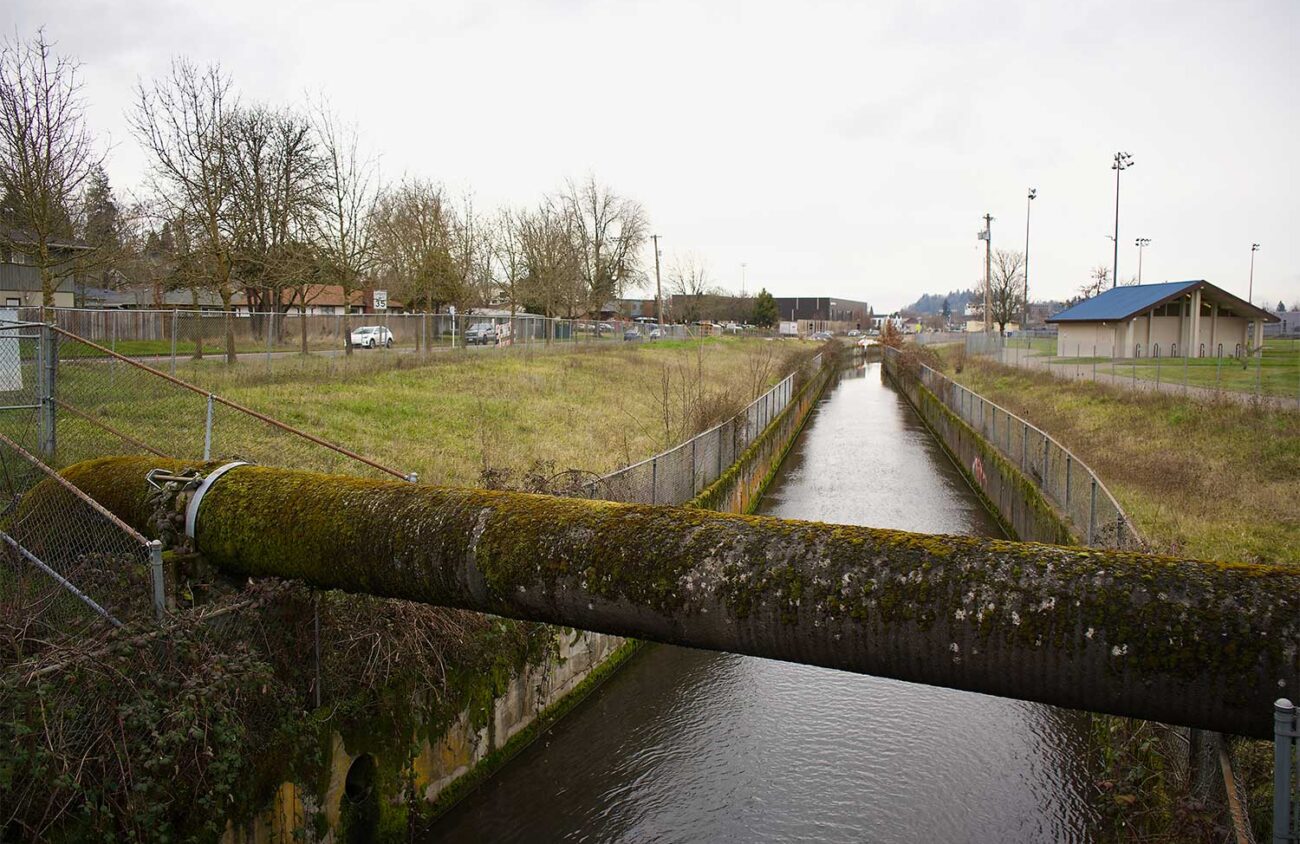Amazon Creek flows from its headwater in Eugene’s south hills near Spencer Butte, through town to the Long Tom River and then to the Willamette. The urban stream not only weaves through Eugene neighborhoods but is also a habitat for fish and wildlife.
The project involves removing a portion of the 66-year-old concrete channel that runs through Amazon Park enclosing the creek between 19th and 24th Avenues and planting native vegetation to restore the ecosystem. The project is on pause but will restart this summer.
Amazon Creek collects the city of Eugene’s stormwater that runs off rooftops, roads and sidewalks. The Oregon Department of Quality listed Amazon Creek as an impaired waterway under the federal Clean Water Act due to low levels of dissolved oxygen, elevated bacteria and turbidity.
The channel was constructed in the 1950s by the U.S. Army Corps to reduce the risk of urban flooding. In fact, there’s speculation the creek’s name comes from its tendency to flood widely, like its namesake Amazon River. Over time, the concrete seems to have created more problems than it solved, including impairments to water quality and rising temperatures.
“Right now, it hits the concrete, and there’s no interaction with the soil or plants. So there’s no filtering of water. There’s no maintaining of a cooler temperature,” says Shelly Miller of Eugene Parks and Open Space.
Project manager Sean Kovensky explains that the concrete channel also poses a potential hazard as large pieces have already begun to fall in the creek. “It’s best to get out ahead and remove it before it becomes a bigger issue,” Kovensky says.
Restoring Amazon Creek has been on the city of Eugene’s to-do list for quite some time. This partial restoration was part of a list of projects to be funded by the $39.35 million Parks and Recreation Bond passed by voters in 2018. The majority of the funding for the restoration is coming from a $2.7 million FEMA Hazard Mitigation grant to cover 75 percent of project costs.
The construction for the restoration, which was originally anticipated to be completed November 2024, has been put on pause through the winter due to weather concerns. Construction will resume on July 1, according to a quarterly report submitted to the Oregon Department of Emergency Management by the city in December.
Planting and seeding for the section of the creek that has already been excavated will continue through the winter.
Miller has a background in aquatic ecology and says she worked with her team to choose species to join the Amazon Creek’s ecosystem that are almost exclusively native and would have a high likelihood of surviving including Oregon grape, dogwood, willow and snowberry.
According to a quarterly report submitted to OEM in July, rapid rises in water levels presented safety hazards to workers, requiring a project deadline extension until December 2025, which was granted by FEMA in October.
Northwest of Eugene, the Long Tom River is the main source of Monroe’s drinking water supply. The City of Monroe Public Water System has faced a series of violations by the Oregon Health Authority for exceeding the maximum contaminant level for trihalomethanes — a harmful chemical that forms as a byproduct of disinfectants interacting with organic matter.
The Long Tom Watershed Council collects data to monitor pesticide levels found in the Amazon Creek. LTWC Habitat and Water Quality Specialist Amanda Reinholtz says that monitoring this data long-term has shown that “urban areas contribute as many or more pesticides to the water as agricultural areas.”
According to a summary of LTWC data from the past three years, some of the most frequent and concerning pesticides found in the Amazon Creek are imidacloprid, an insecticide highly toxic to aquatic bugs; diuron, a herbicide that inhibits photosynthesis; and propiconazole, a fungicide used to treat wood.
By removing the channel and planting vegetation around the creek, this project will hopefully restore a natural streambed and reduce the water temperature. With the concrete channel, the Amazon Creek gets hardly any shade, causing it to reach high temperatures in the summertime, Miller says.
“The work that we’re doing is going to allow the water to flow, have a wider flood plain and have a more natural interaction with its surroundings,” she continues.
Cooler water temperatures are beneficial for organisms living in the stream, keeping sediment out and reducing the number of pollutants.
Even if it’s just a few blocks of restoration, in the long term, folks in the community can look forward to a pleasant amenity to walk or ride a bike or skateboard by and connect with nature again, Miller says.
Help keep truly independent
local news alive!
As the year wraps up, we’re reminded — again — that independent local news doesn’t just magically appear. It exists because this community insists on having a watchdog, a megaphone and occasionally a thorn in someone’s side.
Over the past two years, you helped us regroup and get back to doing what we do best: reporting with heart, backbone, and zero corporate nonsense.
If you want to keep Eugene Weekly free and fearless… this is the moment.
